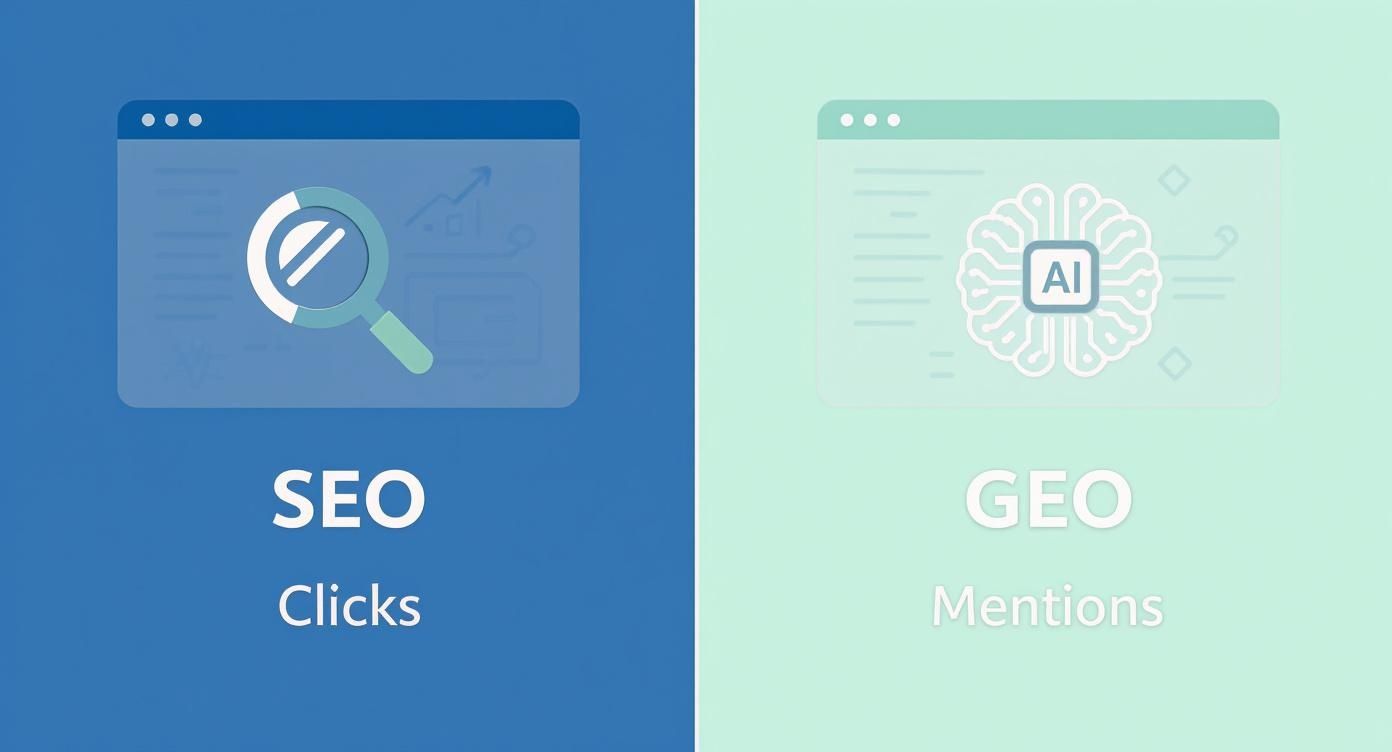Generative Engine Optimization (GEO) is all about making sure your content gets found, understood, and—most importantly—cited by AI tools like ChatGPT and Google’s AI Overviews. The goal is no longer just about winning clicks on a search results page. It's about winning mentions inside an AI-generated answer. This is a fundamental shift that keeps your brand visible and authoritative as more people turn to AI for direct answers.
Unpacking Generative Engine Optimization
Think about it this way. Traditional Search Engine Optimization (SEO) is like crafting the perfect resume for a job application. You pepper it with the right keywords and structure it just so, hoping to get past the initial screening and catch a recruiter's eye. Your goal is to stand out in a long list of candidates and get them to click on your profile (your website).
Generative Engine Optimization is a completely different game. Instead of a simple resume, you're building a comprehensive, fact-checked knowledge base about yourself. You're providing detailed project histories, verifiable data, and clear explanations of your skills. The "recruiter" is now an AI, and it isn't just scanning for keywords. It's looking for credible, structured information it can synthesize into a complete, trustworthy answer for its user.
The goal of GEO isn't just to be seen, but to become a trusted source that directly informs the AI's response. It’s the difference between being a link in a list and being the cited expert in a summary.
This visual breaks down the core shift in thinking from old-school SEO to the new GEO model.

As you can see, the objective has moved from just attracting clicks to earning authoritative mentions right inside the AI-generated content.
The Shift From Clicks To Mentions
For years, the digital marketing playbook was simple: rank higher to get more clicks. But generative AI is tearing up that playbook. Users are done sifting through ten blue links; they’re asking complex questions and getting direct, synthesized answers. This means your website's visibility is no longer guaranteed by a top ranking alone.
This change is happening fast. GEO really started to take shape as a distinct practice around 2024, right as large language models (LLMs) began to mature. As of mid-2025, Google’s AI Overviews now show up in roughly 13% of search queries globally. That figure has doubled since the start of the year, signaling a massive change in how information gets delivered at the very top of search results.
This table highlights the key differences between the old world and the new.
Traditional SEO vs Generative Engine Optimization
While traditional SEO still has its place, GEO addresses the new reality of how users are finding information. The two aren't mutually exclusive; a strong GEO strategy actually builds on a solid SEO foundation.
Why GEO Matters for B2B SaaS
For B2B SaaS brands, this transition is especially critical. Your potential customers are already using AI to research solutions, compare features, and make buying decisions. If your content isn't built for these "generative engines," your brand becomes invisible in the exact moments that matter. The key is to stop thinking of your content as a sales pitch and start treating it like a reliable resource.
This means you need to get serious about:
- Creating Factual Content: Produce verifiable, data-driven content that an AI can actually trust. Think less marketing fluff, more hard facts.
- Using Structured Data: Employ schema markup to give AI models the context they need to understand what your information is about and why it’s credible.
- Building Topical Authority: Become the undisputed go-to source on specific topics within your niche. You want the AI to see you as the expert.
By mastering GEO, you ensure that when an AI answers a question about your industry, it uses your brand's information to do it. For a deeper dive into these foundational concepts, we recommend reading A Guide to Generative Engine Optimisation.
How Generative AI Is Reshaping Search

Generative AI isn't just another tech trend—it's completely rewiring how people find information. The old ritual of typing keywords into a search bar and sifting through blue links is fading fast. Users now expect something different, something better.
They’ve moved on from short, fragmented queries to asking complex, conversational questions. Instead of piecing together an answer from ten different tabs, they want a single, clean, synthesized response from tools like ChatGPT or Google's AI Overviews. This seismic shift is exactly why we need to talk about Generative Engine Optimization.
From Keywords To Conversations
Think about the old customer journey. Someone looking for project management software would search "best project management tools for startups," open a bunch of tabs, read reviews, and manually compare features. It was a research project, and they were the researcher.
Today, that same person just asks an LLM: "What are the top three project management tools for a remote SaaS startup with under 10 employees that needs to prioritize budget and integrates with Slack?" The AI doesn't just return links. It delivers a direct, summarized answer comparing the options and often making a recommendation.
This shift from research assistant to answer engine creates a massive new challenge: if the AI gives the full answer, the user has zero reason to click through to your website. This is the new reality of the "zero-click" search.
For B2B SaaS brands, this is a code-red moment. Your entire content strategy was likely built on pulling in organic traffic from high rankings. But now, even a #1 spot on Google doesn't guarantee a visitor if an AI has already scraped and summarized your content for the user.
The Rise of The Zero-Click Search
This isn't just a theory; the data shows user behavior is changing at an incredible pace. AI-powered search is no longer a niche activity. It's a mainstream way people find information, and it's directly siphoning traffic that used to flow to organic search results.
The numbers are startling. ChatGPT’s daily query volume is massive, and Google's AI Overviews are already popping up on billions of searches, appearing on over 13% of all search result pages. Some analysts even predict that traditional organic traffic could drop by as much as 50% by 2028 because of these AI-driven answers.
In this new world, just ranking on page one isn't enough. If you want to stay visible, you have to find a way to influence the AI's answers directly. Check out our guide on AI search engine optimization to see how to adapt your strategy.
The New B2B SaaS Customer Journey
Let's walk through how a potential customer's research process has changed.
Traditional Journey: The buyer searches "CRM for small business," clicks through a few "Top 10" listicles, visits vendor websites, signs up for trials, and maybe makes a decision after a few days.
AI-Driven Journey: The buyer asks ChatGPT, "Compare the top 3 CRMs for a small e-commerce business, focusing on email marketing automation and customer support features." The AI synthesizes information from sources it trusts and spits out a concise comparison. The buyer might follow up with, "Which of these has the most transparent pricing?"
In the second scenario, the only brands that get mentioned are the ones the AI has already identified as authoritative and credible. Your brand's survival now depends on being a trusted source for the generative engine.
This is where a deliberate Generative Engine Optimization strategy stops being a "nice to have" and becomes absolutely essential.
Alright, let's move from the what to the how. A winning Generative Engine Optimization strategy isn't about finding some new SEO trick to game the system. It’s about building a fortress of credibility so strong that AI models have no choice but to use you as a source.
The goal is to become the most reliable, clear, and authoritative voice in your niche.
Think of your website less like a collection of marketing pages and more like a structured library. When an AI "researcher" (an LLM) needs a fact, it doesn't want to read a novel. It wants to find the right reference book, flip to the correct page, and pull a verifiable quote. Your job is to turn your content into that definitive reference book.
Creating Verifiable and Factual Content
The absolute foundation of GEO is content that is undeniably true and easy to verify. AI models are trained to prioritize accuracy, and they’re getting smarter every day at sniffing out marketing fluff. Your content has to be built on a bedrock of facts, data, and clear sourcing that an LLM can parse and trust.
This means you have to ditch vague claims for specific, provable statements. Instead of saying your software is "industry-leading," say it's "used by 7 of the top 10 companies in the sector, as reported by Industry Gazette." Every major claim needs a citation, a link to original research, or a hard data point.
The new golden rule of content is simple: if you can't prove it, don't say it. Generative engines are becoming the world's fact-checkers, and they reward sources that make their job easy.
This commitment to facts is what builds the trust an AI needs before it will ever cite your brand in a response.
Using Structured and Semantic Data
Humans can figure out context from a webpage's design and layout, but AI models need more explicit instructions. This is where structured data, like schema markup, becomes your secret weapon for GEO. It’s like adding clear labels to your content, telling the AI exactly what each piece of information is.
For example, with schema, you can explicitly identify:
- FAQ Sections: Labeling questions and answers helps AI pull your exact response for user queries.
- Author Information: Highlighting an author's credentials and expertise builds trustworthiness (think E-E-A-T signals).
- Product Details: Clearly defining features, pricing, and reviews makes your solution easy for an AI to compare against competitors.
- Organizational Data: Providing clear info about your company helps establish your brand’s identity and authority.
This technical layer makes your content machine-readable. It removes any guesswork and ensures the AI interprets your information correctly. It's the digital version of adding a detailed table of contents and index to your "reference book," helping the AI find what it needs in a split second.
Building Deep Topical Authority
Generative engines aren't just looking for one great article. They’re looking for a deep, consistent pattern of expertise. To become a go-to source, you need to build topical authority by covering a subject from every possible angle. It’s about creating a tightly interconnected web of content around a core topic.
So, instead of writing one-off blog posts, think in terms of content clusters. A B2B SaaS company selling project management software shouldn't just write a post on "project management." It should create detailed guides on agile methodologies, Gantt charts, resource allocation, team collaboration tools, and budget tracking—and then link them all back to a central pillar page. This signals to the AI that you aren't just a voice on the topic; you are the topic.
Optimizing for Conversational Queries
Finally, a killer GEO strategy means structuring your content around how real people actually talk and ask questions. Users don't just type "CRM benefits" into ChatGPT anymore. They ask, "What is the best CRM for a small business that needs to automate its email marketing?"
Your content needs to answer these conversational, long-tail questions directly. Structure your articles with clear, question-based headings (like the ones in this post) and provide concise, straightforward answers right underneath them. This makes it incredibly easy for an AI to lift your content and use it as a direct answer in its summary—often with a citation pointing right back to you.
A B2B SaaS Playbook for GEO Success

For B2B SaaS companies, Generative Engine Optimization isn't just another marketing channel to consider—it's fast becoming a critical path to growth. Your audience of sharp, technical professionals is already using tools like ChatGPT to vet solutions, compare features, and get straight answers to complex problems.
If you want to win their business, you have to be the trusted source inside those AI-powered conversations.
This requires a shift in mindset. Your content strategy can no longer be just about attracting clicks. It’s about building a verifiable knowledge base that machines can understand and trust. The goal is simple: make your content so clear, authoritative, and easy to parse that AI models prefer citing you over your competitors.
Turn Your Website Into A Primary Source
Your website is ground zero for your entire GEO strategy. It needs to become the definitive, canonical source of truth for your product, your niche, and your industry.
When an LLM goes looking for information, you want it to see your domain as a well-organized, highly credible library of facts.
This doesn't mean you have to rewrite everything from scratch. It's about reframing your existing content into a structured, AI-friendly format. You need to think less like a marketer and more like a technical writer or a librarian.
Here’s a simple checklist to get your on-site content in shape:
- Use Clear Headings: Structure articles with descriptive, question-based headings (H2s and H3s) that mirror the exact queries your customers are asking.
- Provide Concise Definitions: Start your posts by defining key terms clearly, preferably in bold. This makes it incredibly easy for an AI to grab a perfect snippet.
- Present Data in Tables: Any time you list features, compare pricing, or show stats, use a simple HTML table. Tables are structured data, which is exactly what machines love to read and cite.
These small changes turn your website from a collection of marketing pages into a knowledge hub that AI models can rely on.
Master Community Platforms Like Reddit
While your website is home base, the real conversations shaping LLM training data are happening elsewhere. Platforms like Reddit have become treasure troves of authentic, nuanced discussions that AI models use to understand user sentiment and real-world problems.
This is a golden opportunity for B2B SaaS.
Your target audience is already hanging out in subreddits like r/sysadmin, r/sales, or r/projectmanagement, talking about the exact challenges your software solves. Engaging authentically in these communities builds powerful authority signals that AI models pick up on.
Participating in relevant online communities isn't just about brand mentions; it's about embedding your expertise directly into the datasets that train tomorrow's AI. Genuine, value-driven comments become the raw material for future AI-generated recommendations.
The key here is to contribute, not advertise. Answer questions, offer helpful insights, and share your expertise without the hard sell. When you become a trusted voice, the brand mentions will come naturally—and those mentions become powerful citations for generative engines.
This is fundamentally how to rank in ChatGPT: by becoming part of the conversational fabric it learns from.
An Actionable GEO Content Checklist
So, what does GEO-friendly content actually look like in practice?
Below is a simple checklist you can use for every piece of content you create. It’s designed to make sure your articles, whitepapers, and guides are primed for citation by generative AI.
GEO Content Checklist for B2B SaaS
By consistently applying these principles, you're not just writing for people anymore. You're building a library of knowledge that positions your brand as an essential source for the next generation of search.
Measuring GEO Success in an AI World
As generative engines rewrite the search playbook, the old ways of measuring success are starting to feel obsolete. Metrics like keyword rankings and click-through rates just don't tell the whole story anymore.
When your goal shifts from earning a click to becoming a trusted source inside an AI-generated answer, your dashboard has to change, too.
Instead of obsessing over your spot on a results page, the real game is tracking your presence inside the AI itself. It’s time to move beyond simple traffic numbers and ask a better question: "How often is our expertise actually shaping the conversation?"
Shifting to AI-Centric KPIs
Measuring your Generative Engine Optimization efforts means tracking metrics that actually reflect your influence and authority where it matters most now. These are the KPIs that give you a clear picture of your brand's true visibility.
Here’s what your new GEO dashboard should focus on:
- Share of Voice in AI Responses: This is the big one. It measures how often your brand is mentioned or cited by platforms like ChatGPT for queries relevant to your industry. Think of it as the new market share, but for the AI era.
- Citation Quality and Sentiment: It's not just if you're mentioned, but how. Are the citations accurate? Is the context positive? You need to know if the AI is representing your brand the way you want it to.
- Branded Search Lift: When users discover you through an AI answer, their next move is often a direct search for your company name. A spike in branded search volume is a powerful signal that your GEO strategy is working.
From Mentions to ROI
Connecting these new metrics to actual business outcomes is the final piece of the puzzle. While direct attribution can be tricky, you can absolutely trace a line from AI visibility to real revenue.
In the world of GEO, an AI mention is the new top-of-funnel lead. It's an authoritative, third-party endorsement that warms up potential customers before they ever visit your site.
Start by tracking assisted conversions—customers who first ran into your brand through an AI recommendation before eventually signing up or making a purchase. The trust in these tools is only growing. Recent reports show that 63% of users trust AI-generated content when it cites credible sources, highlighting the power of a well-placed mention.
As this space keeps evolving, you'll need the right tools to monitor your performance. For anyone getting started, this list of the best ChatGPT rank tracker tools is a great resource.
Ultimately, getting a handle on these new KPIs is non-negotiable for any brand looking to truly measure marketing ROI in an AI-first world.
Frequently Asked Questions About GEO

Jumping into a strategy like Generative Engine Optimization is bound to bring up a few questions. We get it. Here are some clear, direct answers to the things people ask us most, helping you get your bearings and start thinking strategically.
Does GEO Replace Traditional SEO
Nope. Think of GEO as an evolution of SEO, not a replacement. The two work hand-in-hand.
Traditional SEO is the foundation of your house—all the essentials like technical site health, mobile speed, and domain authority. You can't skip these. Generative Engine Optimization is what you build on top of that solid base. It’s about structuring your content and proving your expertise so that AI models can easily understand, trust, and cite your information.
In fact, a lot of what works for SEO, like building deep topical authority, is exactly what you need to succeed at GEO. The real difference is the end goal:
- SEO Goal: Get to the top of a list of links to earn a click.
- GEO Goal: Get your brand mentioned directly inside an AI-generated answer.
What Is The Best First Step to Take for GEO
The single most important thing you can do is create a "single source of truth" on your website for your core topics. This means building out comprehensive, fact-based content that answers your customers' most urgent questions with absolute clarity.
Your goal is to make your content so undeniably authoritative and easy for a machine to parse that an AI has no good reason to cite anyone else. Turn your key service pages and blog posts into the definitive resource on that subject.
This is all about structure. Use clear, question-based headings. Define key terms simply. Put data and comparisons in simple tables. And always, always cite your sources. This is how you turn your website from a collection of pages into a trusted knowledge base for generative engines.
How Long Does It Take to See GEO Results
Patience is the name of the game here. GEO is a long-term play. You're building the kind of deep trust and authority that makes an AI consistently cite your brand, and that doesn't happen overnight. It's an investment in your brand's future credibility.
How long it takes will depend on a few things, like how competitive your industry is, your site's existing authority, and how consistently you're shipping high-quality content. You might start seeing a few mentions for very specific, long-tail questions within 3-6 months. But becoming the go-to authority for broader, more competitive topics? That could easily take a year or more of dedicated work.
At PimpMySaaS, we specialize in building the authority B2B SaaS brands need to get cited by AI. We create and manage conversations on platforms like Reddit that LLMs use for training, ensuring you become the answer. Learn how we can get you mentioned.
